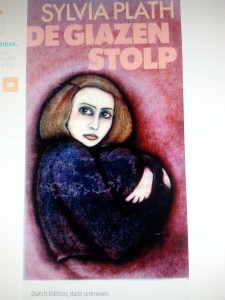Category Archives: Sylvia Plath
Part 1
There are many covers around the world that distinctly represent their respective novels. The novel, “The Bell Jar” by Sylvia Plath had several covers since it was first published. At the time, Sylvia also went by the name Victoria Lucas. There are two specific covers that stand out to me the most. The first, is the cover published by Bantam Press on April 1972. The other cover is the novel’s newest 50th anniversary edition by Faber and Faber published in 2013. Both novel covers portray their own messages which relate back to the story and the main character Esther.
The first novel cover was published by Bantam Press on April 1972. It is a dying rose, or based on the novel, a lifeless rose. I chose this because it lacks a connection from the title of the book and also represents a feminine essence. In the novel, Cee hands Esther a paper rose from the hat she was wearing. “When they asked me what I wanted to be I said I didn’t know. “Oh, sure you know,” the photographer said. “She wants,” said Jay Cee wittily, “to be everything. I said I wanted to be a poet. Then they scouted about for something for me to hold. Jay Cee suggested a book of poems, but the photographer said no, that was too obvious. It should be something that showed what inspired the poems.” (Plath, Chapter 9) In the novel, Esther, was on the verge of tears when her picture was about to be taken. In the previous chapter she had even tried hurting herself during her trip with her boyfriend. I believe the rose represents something very meloncholy. The rose in the novel and the cover depicts that moment of sadness and also represents Esther’s lack of inhibition when she was asked what she wanted to be which is constantly mentioned throughout the story. In the bottom of the cover it says, “The Heartbreaking Story of a Talented Young Woman Who Descends Into Madness.” This is what the entire novel is typically about, a character with a promising future who who dwindles into insanity.
In the cover of the novel by Bantam, the rose is held by a dark hand. The hand is holding the dead rose down towards the bottom. This can be interpreted as a certain darkness that holds her in her life. Esther is symbolized as the dying rose. The dark hand which is holding her is pointing her downwards like the direction which her life is going over the duration of the novel. Like the rose which looks hurt and abused, I assume Esther is hurt mentally from her attempts at meaningful relationships. Through society expecting her to lose her virginity after a healthy marriage, she seeks to take her future into her own hands by embarking on a sexually experimenting journey. After a turn of events, she is unable to seek out her desires as the man she pursues does not pursue her back. Slowly, a madness is descending upon her. After Ester’s first shock treatment, she was unable to recognize the woman in the reflection of an elevator she was in, even though the woman was her. She perceived the lady in the reflection as another woman in the room. Esther, very much like the rose on the cover of the novel is abused, and held downwards towards her end as several of her suicide attempts cause her to be locked into a mental illness hospital. She could not even recognize her bruised and discolored face in the mirror, and could not tell if the “creature” she saw in the reflection was a man or woman. She is neglectful towards her mother as Esther does not see the damage she is causing her, which is a symptom of her mental illness. The dark hand which is holding Esther, the rose, symbolizes this mental illness which slowly consumes her throughout her journey.
The second cover I chose is the 2013 version by Faber and Faber that caused a lot of controversy for the novel’s 50th anniversary edition. It misintereprets the true meaning of the book by displaying a very bright cover with a woman holding a compact case to her face. The aspect of the novel that this cover supposedly relates to is the beginning when Esther starts working as an intern for the woman’s magazine company over the summer and it also represents the 1950’s, the time in which this story took place. The cover is ultra feminine, I suppose to represent her working along other women throughout the summer. “So there were twelve of us at the hotel, in the same wing on the same floor in single rooms, one after the other, and it reminded me of my dormitory at college. It wasn’t a proper hotel — I mean a hotel where there are both men and women mixed about here and there on the same floor.” It is a very girly cover, perhaps trying to convey to the readers that this is about a woman, a woman with style. The scene where this part of the cover is mentioned is when Esther discusses all her gifts. “I still have the make-up kit they gave me, fitted out for a person with brown eyes and brown hair: an oblong of brown mascara with a tiny brush, and a round basin of blue eyeshadow just big enough to dab the tip of your finger in, and three lipsticks ranging from red to pink, all cased in the same little gilt box with a mirror on one side. I also have a white plastic sunglasses case with colored shells and sequins and a green plastic starfish sewed onto it. I realized we kept piling up these presents because it was as good as free advertising for the firms involved, but I couldn’t be cynical. I got such a kick out of all those free gifts showering on to us.” (Path, Chapter 1)
Another way one could interpret this cover is by assuming that the woman adjusting her make up has two faces. She has a face she adjusts for the whole world to see. A face and image that is very different from how she is feeling within. This is the case with Esther through the beginning and middle of the story. She keeps up a facade and her thoughts are different from her behavior. I believe this cover is very misleading because it doesn’t effectively represent what the book is about thus all the controversy over it. According to many websites and blogs, people may get the misconception that this is a chick lit, not about a woman with depression because of the bright red coloring. The cover isn’t very creative and lacks depth compared to all the other ones. Another thing I noticed is that in the 50th anniversary cover, the woman has her eyes closed as she is applying make-up from an empty make-up pallet. She also seems to have a very mild frown on her face. This part of the cover image can be interpreted as how her life throughout the beginning of the novel was depressing for her. In this part of The Bell Jar, she is not content with the lifestyle she is living as she compares herself to the other women living in the hotel with her. She sees herself in the mirror and does not feel that she wants to be the woman that everyone else wants her to be. Perhaps the empty make-up pallet resembles how she is done with putting on a cover and is ready to act in the way she feels she should, not what society “makes-up” for her.
After analyzing these two covers I learned that covers given to a novel are not always easily comparable to what their meanings are or how they portray towards the novel itself. “The Bell Jar” is a novel about the journey of a young woman who sees the flaws of society in her time, who behaved unconventionally as her “dark passenger” started to take the wheel. The covers given to this book by both The Bantam Press and Faber and Faber, each had their own hidden messages. For the Bantam Press, the cover was a depiction of Esther herself as a rose who was once very much alive during her childhood, but in time, after being held by darkness, slowly shriveled away into a deathly state. As for the Faber and Faber cover, Ester is a modern-like girl who sees her reflection and does not seem to approve of what it looks like.
My Cover
Part 2
I chose to create this cover because it reminds me of the story of Esther Greenwood in The Bell Jar. The rose is red and fiery which represents the inner Esther. Flowers are life , without the proper care a rose will die. The background is scenic, but camouflaged through the off white petals. That scene represents the beautiful death that Esther imagines as she is trapped inside this bell jar. The beautiful rose is suffocating, as Esther Greenwood in The Bell Jar.
One and Fifty (The Bell Jar a Covers)
The Bell Jar by Sylvia Plath has many themes. The themes for this novel were expressed in the novel through words as well as through the illustrations on the cover. The Bell Jar has had many covers since it’s first official publication.
The Bell Jar, first Heinemann edition, was published on January 14, 1963 under WillIam Heinemann Ltd. . This Novel was published under the pseudonym Victoria Lucas. Sylvia Plath used this fictitious name in an attempt to avoid hurting the people she cared for in America. Sylvia Plath actually requested that The Bell Jar never be published in America. Sylvia Plath died , said from suicide, shortly after the release of this novel. Hughes gave permission to have her name revealed. Sylvia Plath attempted to publish her novel before William Heinemann Ltd. . The Bell Jar was rejected by Eugene F. Saxton fellowship , affiliated with Harper and Row. They were said to be disappointed in the manuscript. The novel which first names were “Diary Of A Suicide” and “The Girl in The Mirror”. This novel was said to be juvenile and overwrought by Eugene F. Saxton fellowship. Though rejected in the past by Harper and Row, Heinemann Ltd. Saw something special in this novel.
A bell jar is a bell shaped usually glass vessel designed to cover objects or to contain gases or a vacuum.(www.https//:merriamwebster/belljar)The cover of the first published novel of The Bell Jar has interesting artwork of a woman sitting in a chair, inside of a bell jar. This to me is symbolic to one or more of the themes in the novel.
One theme that comes to mind in comparison of the illustration on the cover of the first published edition of The Bell Jar by Sylvia Plath is suppression. The fact that this woman on the cover of the novel is closed inside of a bell jar is metaphorical to Esther being trapped inside the world that she lives in. Esther was unlike any of the other girls that she stayed in the all girls hotel with in New York. More times than not she would suppress her thoughts and true feelings in fear of judgement from others.
Another theme that comes to mind when analyzing the cover of the first publication of the novel is death. This death would be through suffocation. It is all symbolic to the death of the person who appeared to be Esther and the person Ms.Greenwood really was. “Death must be so beautiful . To lie in the soft brown earth, with the grasses waving above one’s head, and listen to silence. To have no yesterday, and no tomorrow. To forget time, to forgive life, to be at peace. ” Life and all that it involved, to Esther seemed to be suffocating and the thought of death would be more peaceful.
The woman inside the bell jar on the cover of the first publication has body language displaying stress and grief, being suppressed, and suffocating inside a glass jar. The illustration of the cover depicts this moment in the story by displaying such disgust with life that she feels that whatever death had to offer must be beautiful. Esther Greenwood wold bet that death was better than life. This cover was just the beginning of the many covers to follow.
In 2013 the 50th Anniversary edition of The Bell Jar was published. This edition was done by Faber and Faber. This illustration of The 50th anniversary edition was criticized by many of the readers and followers of Sylvia Plath’s poetry. This cover was said to glorify the story of depression and suicide that was initially being told by Sylvia Plath. Critics say that this cover will attract only a female group of readers due to the bias art on the cover. Many of Ms.Plath’s readers suggest that Sylvia Plath would herself be unsatisfied with this new cover published by Faber and Faber.
This cover has a picture of a woman looking into the mirror of a compact makeup palette. This woman looks suspenseful, and is applying bright red lipstick . The background is also in a bright red color. Though the red color will bring attention to the book itself , the illustration may stray some readers away. True Sylvia Plath followers understand what’s conveyed in the book as opposed to what is on the cover.
Faber and Faber stands behind the publication of the 50th Anniversary Edition . Faber and Faber’s intention was to keep backlist novels like ” The Bell Jar” in the hands of new readers. They believed that the new packaging of the novel was to draw new readers to old writing.
The Bell Jar by Sylvia Plath has many themes. Amongst these themes would be depression, suicide, suppression, and death. Freedom, liberation, and women’s independence are rarely discussed in reference to “The Bell Jar”. Though Esther Greenwood lived in a time of oppression mentally, her conscious was aware. It seemed that her depression may have originated subconsciously as a result of her upbringing, and mentality. Had Esther not held this stigma of mental Illness her aspirations may have reached their full potential.
In the 1950’s Esther interned at a magazine in New York. While Interning Esther stayed at a hotel called the Amazon. She had initially rejected those women who lived at the all women’s hotel . That rejection was in fear of rejection from these well to do women. Esther felt that she was different. Though thoughts of freedom to be liberated exist the pressure of being who everyone else would expect was over baring.
Esther Greenwood did not like the idea of being overpowered or protected In a world where she was expected to do just that. “To the person in the bell jar, blank and stopped as a dead baby, the world itself is a bad dream”. Her liberation was thought, but never enacted. Esther had been held so long to the preservation of being protected and thought for, she feared the security of a man. “That’s one of the reasons I never wanted to get married. The last thing I wanted was infinite security and to be the place an arrow shoots off from. I want change and excitement and to shoot off from a Fourth of July rocket”.
Red is a noun, one of its meanings are , emotionally charged terms used to refer to extreme radicals or revolutionaries(dictionaryapp). Not only is the cover of the new 50th Anniversary edition of The Bell jar red, but the woman on the front is applying bright red lipstick as well. The cover of this new edition seems to be a bit misleading. You will get a different idea from the cover then the actual story being told. Women were actually assumed to be domestic beings, and in accordance with the prospect of being what society thought them to be.
The new cover for The Bell jar has a conspicuous suspiciousness. The first cover of the Bell Jar published in the UK in 1963 had a more apparent look. When you looked at the image of this woman being stuck inside of a bell jar like an ornament, you get the sense that she is suppressed. I understand the controversy and ambivalence about the new cover for The Bell Jar.
The new cover states excitement, mischief and mystery. The fact of the matter is that The Bell Jar by Sylvia Plath is a manuscript about a woman who is depressed and trying to fight the demons of suicide. Esther Greenwood was dreaming of freedom and liberation, while suffocating in that glass jar from oppression. The new cover makes The Bell Jar appear to be a new and different story.
There is a big difference in the cover of the first published edition of The Bell Jar by Sylvia Plath, published under the name Sylvia Lucas in comparison to the 50th Anniversary cover published in 2013 by Faber and Faber. The first cover tells the story , the most recent cover is deceptive. Overall throughout all of the controversy and the changing covers of The Bell Jar by Sylvia Plath, the story of “Esther Greenwood” remains the same. The different covers just represent the perceptions of novel “The Bell Jar”.
www.wikipedia.com/sylvia plath/thebelljar
www. Fabero.co.uk/about/press/bell-jar
Discussion for Tuesday: Final thoughts on The Bell Jar
As we finish The Bell Jar and finalize Project #2, what final thoughts do you have? Specifically, what do you think about the ending? What do you understand better about earlier parts of the novel now that you have finished it and come to understand Esther’s character and experiences? Write a comment–roughly 150 words–here by Tuesday, and reply to another comment–100-150 words by Thursday–to help us wrap up our discussion.
A few other points:
I will post on Tuesday another comment-and-reply request for the texts we’re discussing in class this week.
Remember that if you want to meet with me to discuss Project #2, there are appointments available on Tuesday and Wednesday. If you meet with me for one of those appointments, I will extend your deadline for Project #2. So far, about a third of the class has signed up. If you are interested but no times fit your schedule, please let me know as soon as possible and I will see if I can add in a time to accommodate you.
I look forward to meeting with you, and to reading your comments and projects!
Group Post: Is Doctor Nolan a better mother to Esther then her own mother?
On page 212 the first half of the page is the dialogue between Esther and Doctor Nolan. To summarize the conversation its about when Esther is going in for her shock treatment and Esther is caught off guard with Doctor Nolan and begins yelling at her saying “You said you would tell me!” To which Doctor Nolan responds explaining that she came to be with her and make sure everything is done correctly this time around.
My group and I took the conversation to mean that Esther is closer to Doctor Nolan then her own mother in a sense that she trusts her more. Esther is not afraid to lash out towards Doctor Nolan. We also agreed that Doctor Nolan sort of took Esther under her wing. We literally see this happen after Doctor Nolan wipes Esther’s face with her handkerchief and hooks her arm around her and escorts her to the room.
The Meaning of a Cover
The Bell Jar by Sylvia Plath is a novel about a young woman’s descent into depression and mental illness. It is the story of Esther Greenwood a nineteen year-old woman that actually seemed to be quite lucky. She went to a good university, had a loving mother, an aspiring doctor as a boyfriend, she even won a contest and a trip to New York with a famous women’s magazine. Even with all of that she felt different and unhappy and trapped. She behaved erratically developed a different identity and desired to commit suicide. This story reflects the own life of the author as well, who not too long after publishing the book succeeded in her last attempt and commited suicide. It is evident that this novel is fairly morbid and deep, and it is also a world famous novel.This novel has been translated to many different languages and the cover art has been very different for each country. It is noticeable that each country has a different take on what cover is most befitting to this novel. Some cover arts are like the one from the Dutch edition of the novel; titled, De Giazen Stolp This cover shows a woman in long black clothing slumped on the ground and hugging her knees to her chest while looking up. This cover art idea could be extracted from the section just before Esther goes to the mental hospital, where she decides to crawl into a hole in her basement while overdosing on pills. This cover clearly shows that the book is about the darkness and struggles of a young woman. It is an appropriate for anyone wondering what this novel holds behind that cover. Other covers for this book, American covers in particular, decide to go in a different direction with their designs. The cover from the publishers “Faber and Faber” from the year 2009 take a lighter approach to the cover design. This version shows a woman with a model figure in an non-distinctive white strapless gown with seemingly long hair gathered in a low bun. After knowing exactly what the book is about, this cover seems rather innapropriate. This looks more like a novel about a bride at her wedding. It can only be imagined that this cover idea came from the beginning of the novel where Esther is still in New York living the dream of every other girl her age. Because this version of the novel is somewhat current, it can be inferred that the company went with this friendlier idea to encourage more sales with a younger, more modern generation. There is a famous saying that goes, “you cannot judge a book by it’s cover.” Though this is true, there should be a limit to how far off the subject of a novel the cover art should stray. To those who have not read that book, they would be mislead; and to those who have read it, they will be disgruntled to say the least.
Project #2 Draft: A Woman Alone
Suicide
In chapter 13 of The Bell Jar Esther tries to kill herself after an interaction with Cal. Cal was the boy who Jody had wanted her to meet. They discussed for a while suicide with a shotgun, and things of that nature. the next morning Esther tried to kill herself with a silk cord of her mothers. Though Esther was mentally Ill, she would decide to use whatever sense she had in order to decrease her chances of being out into a mental institution.
Suicide is associated with many things, from peer pressure to mood disorders. In the past 45 years rates of suicide have increased by at least 60% in some countries. This has been the leading cause if death among ages 15 – 34 throughout the world. Attempted Suicide is considered a strategic action to resolve conflict within themselves, parents or peers. This is also considered to be a distress signal, aiming for the empathy, of others. Mental Health and suicide go hand and hand. Of 15, 629 cases of suicide with information on psychiatric diagnoses was over 50 percent. Disorders such as depression, which is a mood disorder, also associated with suicide had numbers of 35.8 percent of reported suicide deaths.
“That morning , I had tried to hang myself. I had taken the silk cord of my mothers yellow bathrobe As soon as she left for work, and in the Amber shade of the bedroom, fashioned it into a knit that slipped up and down on itself. It took me a long time to do this, because I was poor at knits and had no idea how to make one” this is just an example of how much concentration you have to put into killing yourself. There has to be some reasoning fir this type of dysfunctional Irrational behavior. Suicide has been on the rise for years.
bjp.rcpsych.org/content /183/5/382.full
The Bell Jar: Fig Tree
After finding out that Buddy was not as innocient as she, Esther become very upset at the thought of Buddy . As she laid in bed, Esther opens the book sent to her by the ladies day magazine stuff. She goes through the book and she a story about a fig free. The Fig tree grew on a green lawn between the house of a jewish man and a beautiful nun. The nun the jewish man meet under the tree and they continously kept meeting under the tree. One day as they watch an egg hatching in a birds nest, they touched hands. The next day the nun didn’t come out anymore to pick fig fruits. Esther compares the story to her relationship with Buddy. They had meet in their own imaginary fig tree, and after seeing a baby coming out of a women; they went their separate ways. Later in the novel, i believe the fig tree becomes a symbol of the life choices the Esther faces. For instance her constant attempt to kill herself.
The first fig is believed to be native to Western Asia and has been distrubuted by man throughout the Mediterranean sea. The fig tree is small dimensional tree that has numerous branches and a trunk rarely more than 7in in diameter. It consist of a copious milky latex and tiny flowers are massed inside the cell wall. The tree varies in color such as yellowish to copper, bronze or dark purple and the skin is thin and tender. The fig can be grown in a large range of soil, such as light sand, rich loam, and heavy clay or limestone. There are many culivated variities in each fig class. In fact there is about 700 different kinds. The most popular ones are Celeste and Brown turkey. Some fig are used for eating out the hand and others can be dried into coffee. In mediterranean countries, low grade gigs are converted in alcohol.









